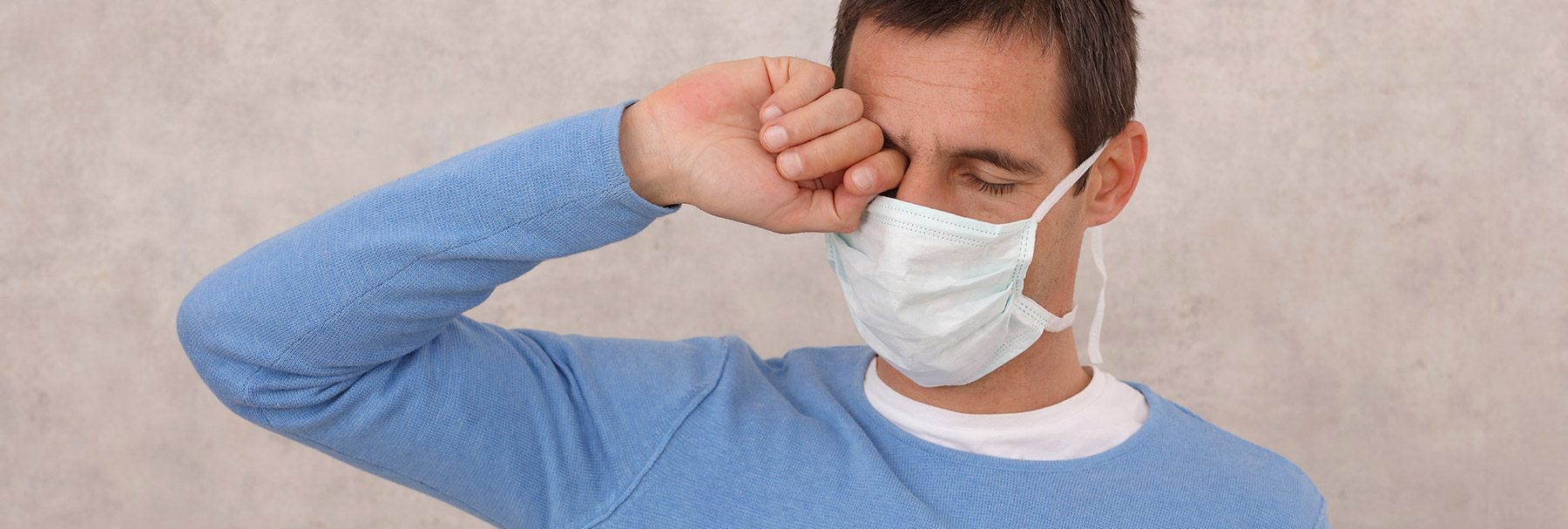Can Wearing Masks Irritate Your Eyes?

Have you recently noticed that your eyes feel dry and tired lately? Or perhaps you’re experiencing the uncomfortable pain and irritation associated with a stye for the first time in your life? You’re not alone, and your mask could be to blame.
However, don’t throw away your mask. With Omicron spreading like wildfire across the United States, this easy safety measure is more important than ever. There are ways you can mask up and limit eye discomfort.
Mask-associated dry eye
This is not a new phenomenon.
In August 2020, the Centre for Ocular Research and Education published an alert on an increase of reports of mask-associated dry eye or MADE. More recently, results from an anonymous survey of 3,605 people published in 2021 in the Contact Lens & Anterior Eye Journal found that 18% of respondents reported that masks increased dry eye symptoms and discomfort.
If you are suffering from MADE, you may be wondering if that means you have dry eye disease. Anat Galor, M.D., a cornea specialist with Bascom Palmer Eye Institute, says dry eye, dry eye symptoms, and dry eye disease are constellations of symptoms and signs. Each patient probably has their specific contributors driving their symptoms and signs.
In her office specifically, they’ve seen more chalazion and styes than ever before, and she attributes that to mask-wearing.
Dr. Galor says that a chalazion, a small, typically painless lump on the edge of the eyelid, is the chronic presentation of a stye. “When you have a stye, your eyelid is puffy and sore. Then, the stye develops into a focal ball of redness as it progresses. Over time, the redness dissipates, and you are left with a chalazion that will either go away on its own or can be treated by a physician.”
Air gets in your eyes
There is always airflow around your eye. However, if you are wearing a mask incorrectly, there is increased airflow to your eyes that may even create a “bacteria funnel,” according to a report in the November 2021 issue of the Review of Optometry magazine. “It essentially comes down to too much air being directed into the eyes over an extended period and bacteria infiltrating the OS (ocular surface).”
You are shooting hot air that has air particulates from your breath up to your eyelids, and we believe that this is exposing people to having what we call meibomian gland dysfunction, which is a subtype of dry eye, says Dr. Galor.
The meibomian glands are responsible for creating the lipid layer of the tear film, which protects the ocular surface. “That layer seals in the water and keeps the tear layer stable,” says Dr. Galor. “Any disorder of the meibomian glands can manifest with an unstable tear film and meibum plugging, which can lead to the development of a stye.”
Tips for wearing your mask properly
Since the COVID-19 pandemic is still with us, it is imperative that you continue wearing a mask.
You can limit any associated eye discomfort. It starts with making sure that your mask seals well.
A mask with a tight seal offers the most protection from COVID-19.
It should fit snugly on your face, and don’t wear it too high up on your face to where it keeps your bottom lid from meeting your top lid.
One option is to wear a mask that has a nose clip. You can also put a piece of tape over the top of your mask; just make sure it is not interfering with your ability to blink.
Also, consider different mask options. If one mask doesn’t fit correctly, another one might be better. There are a variety of masks available, and even N95s and KN95s come in different shapes and sizes. The CDC site has instructions on correctly.
In addition, take breaks from wearing your mask throughout the day when it is safe to do so. For example, take a walk outside away from other people for a few minutes if possible.
A daily eyelid hygiene routine
Cleansing your eyelids every day to promote eye wellness can help as well. It is the same concept as brushing your teeth every night. Doing so will remove the debris and bacteria that can irritate the ocular surface and lead to blockage of the Meibomian glands. Following up with a moist warm compress can also relieve eye discomfort.
“Eyelid hygiene is a good idea in general, but it’s even more important now that we’re wearing masks,” says Dr. Galor. There are many different strategies that you can do, but it involves cleaning your eyelids, either with warm water or with a medication that’s meant for the eyelids.
“You are taking the debris off your lashes and off the orifices that are the openings for the lipids and cleaning them so that that debris doesn’t fall into your eye and irritate it, and then you’re opening the orifices so that lipids can flow,” Dr. Galor says.
Natasha Bright is a contributing writer for UMiami Health News. You may have read her writing on the Huffington Post and Scary Mommy websites.
Tags: Bascom Palmer, Dr. Anat Galor, dry eyes, eye irritation, stye
